W. Jason Morgan facts for kids
Quick facts for kids
William Jason Morgan
|
|
|---|---|

Morgan receiving the National Medal of Science from George W. Bush in 2003
|
|
| Born | October 10, 1935 Savannah, Georgia, U.S.
|
| Died | July 31, 2023 (aged 87) Natick, Massachusetts, U.S.
|
| Alma mater | Georgia Institute of Technology Princeton University |
| Awards | Maurice Ewing Medal (1987) Japan Prize (1990) Wollaston Medal (1994) Vetlesen Prize (2000) |
| Scientific career | |
| Fields | Geophysicist |
| Institutions | Princeton University |
| Doctoral advisor | Robert H. Dicke |
William Jason Morgan (born October 10, 1935 – died July 31, 2023) was an American geophysicist. A geophysicist is a scientist who studies the Earth using physics. Jason Morgan made very important discoveries about how our planet works.
He was a professor at Princeton University for many years. He helped us understand plate tectonics and how the Earth's deep interior moves. His ideas changed how scientists think about our planet.
Contents
Jason Morgan's Big Ideas in Earth Science
Jason Morgan earned his first degree in physics from the Georgia Institute of Technology in 1957. Later, he went to Princeton University and got his PhD in 1964. After finishing his studies, he started teaching at Princeton.
Understanding Plate Tectonics
In the late 1960s, Jason Morgan made a huge discovery. He connected the stripes of magnetic patterns found on the ocean floor to something called seafloor spreading. Imagine the ocean floor slowly pulling apart at places called mid-ocean ridges. As it pulls apart, new rock forms. This new rock records the Earth's magnetic field, which flips over time.
Morgan showed that these magnetic stripes proved that the Earth's surface is made of huge pieces, like puzzle pieces, called tectonic plates. These plates are always moving, slowly sliding past each other or bumping into each other. This idea is known as plate tectonics.
The Mantle Plume Theory
Later, in 1971, Jason Morgan helped develop another important idea called the plume theory. This theory explains why some places on Earth have volcanoes that are not near plate boundaries. Think of places like Hawaii.
The plume theory suggests that there are hot, rising columns of rock, like giant chimneys, deep inside the Earth's mantle. These columns are called "mantle plumes." When a plume reaches the Earth's surface, it creates a very hot spot, or hotspot, which can cause volcanoes to form.
Morgan showed how the Hawaiian islands got older the further they were from the current hotspot. This proved that the Pacific plate was moving over a fixed mantle plume.
Awards and Recognition
For his amazing work, Jason Morgan received many important awards. These include the Maurice Ewing Medal in 1987, the Japan Prize in 1990, and the Wollaston Medal in 1994. In 2002, he was given the National Medal of Science by the USA. This is one of the highest honors a scientist can receive in the United States.
A fellow scientist, F. A. Dahlen, said in 2003 that Jason Morgan's plate tectonics theory was one of the most important scientific achievements of the 20th century in the U.S. He also said that almost all research in Earth science for the past 30 to 35 years has been based on Morgan's ideas.
See also


